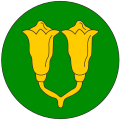| Coat of arms of Tanzania | |
|---|---|
 | |
| Armiger | United Republic of Tanzania |
| Adopted | 6 May 1971 |
| Shield | On a native shield, per fess of four: Or, the top part of a Torch enflamed proper; Flag of Tanzania: Per bend sinister Vert and Azure, a bend sinister Sable, fimbriated Or; Gules, an Axe and Hatchet in saltire Or; Barry wavy Argent and Azure; over all a Spear over an Axe and Hatchet in saltire, all Or. |
| Supporters | A representation of Mount Kilimanjaro. Elephant tusks are supported by a man and a woman, with a clove bush at the feet of the man and a cotton bush at the feet of the woman. |
| Motto | Uhuru na Umoja "Freedom and Unity" (Swahili) |
The coat of arms of Tanzania comprises a warrior's shield which bears a golden portion on the upper part followed underneath by the flag of Tanzania.
Contents
The golden portion represents minerals in the United Republic; the red portion underneath the flag symbolises the rich fertile soil of Africa; and the wavy bands represent the land, sea, lakes and coastal lines of the United Republic.
In the golden part of the flag, there appears a burning torch signifying freedom (Uhuru), enlightenment and knowledge; a spear signifying defence of freedom and crossed axe and hoe being tools that the people of Tanzania use in developing the country.
The shield stands upon the representation of Mount Kilimanjaro. Elephant tusks are supported by a man and a woman, with a clove bush at the feet of the man and a cotton bush at the feet of the woman (whose head is covered with a golden scarf) indicating the theme of co-operation.
The United Republic motto below –Uhuru na Umoja– is written in Swahili and means "Freedom and Unity".





